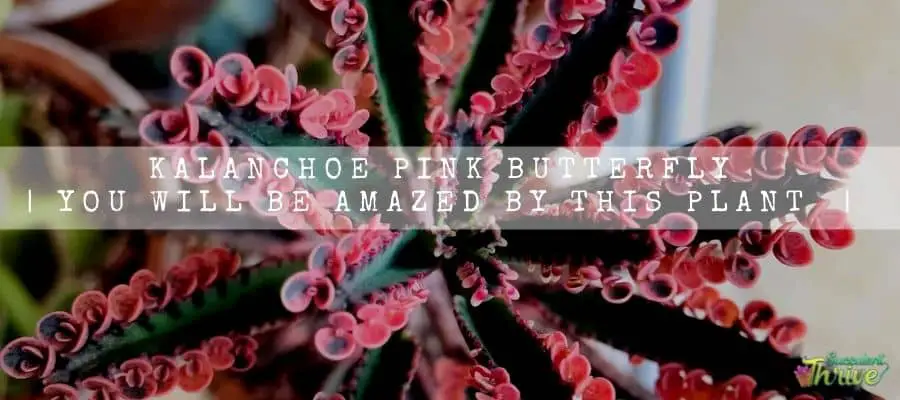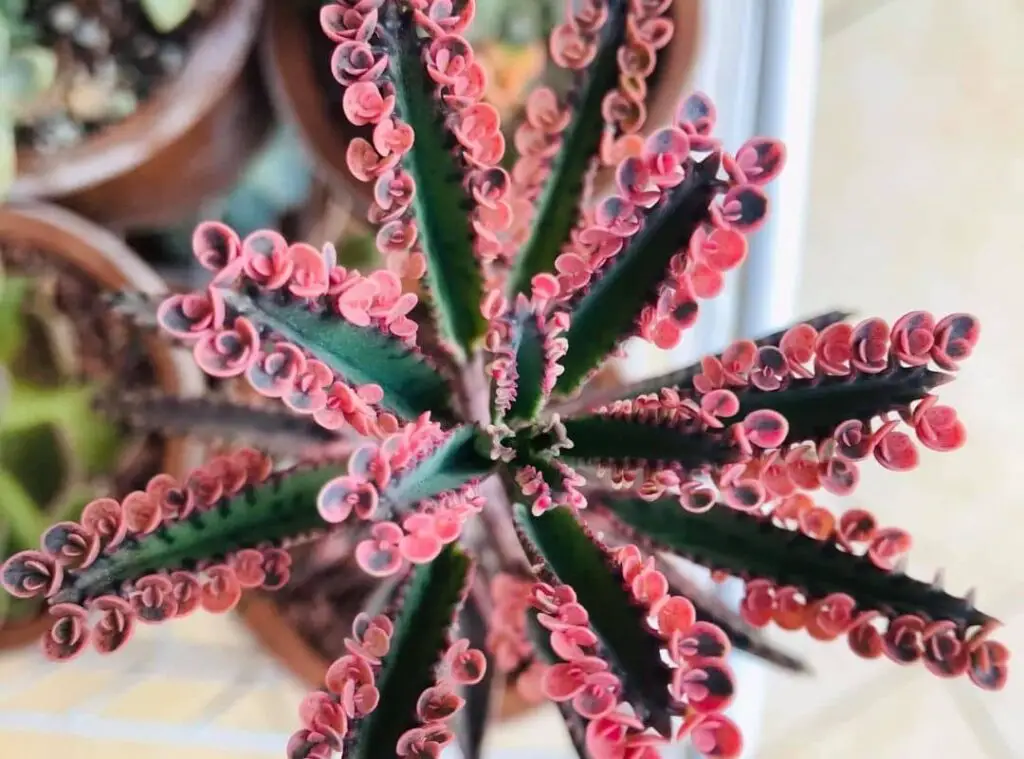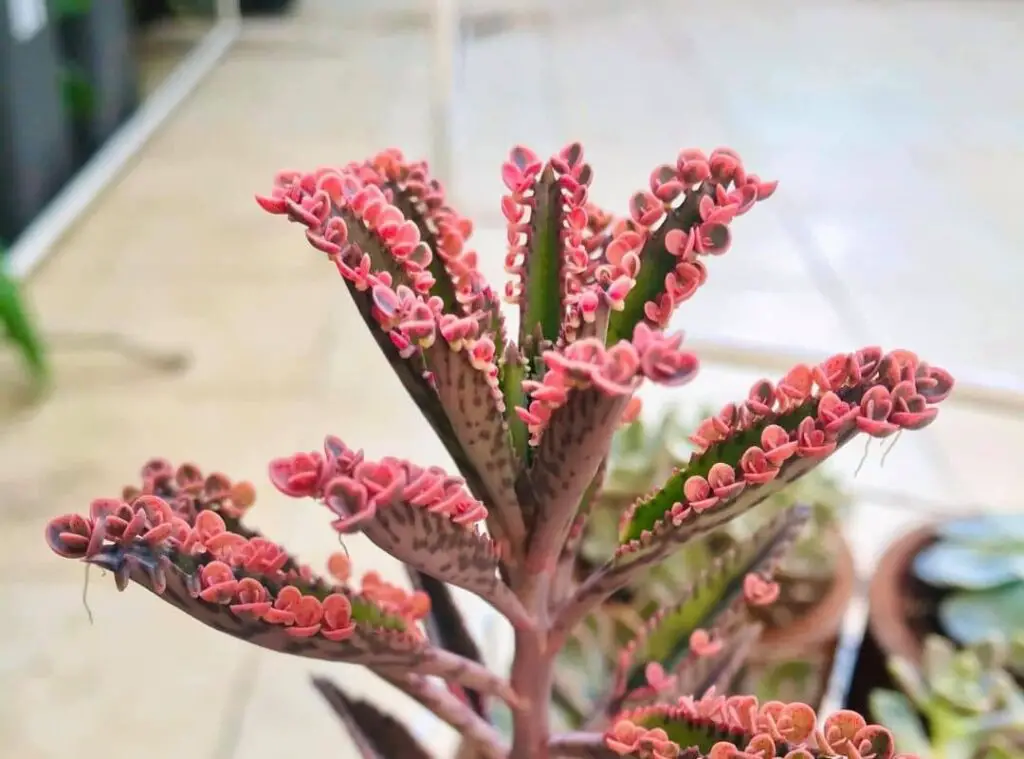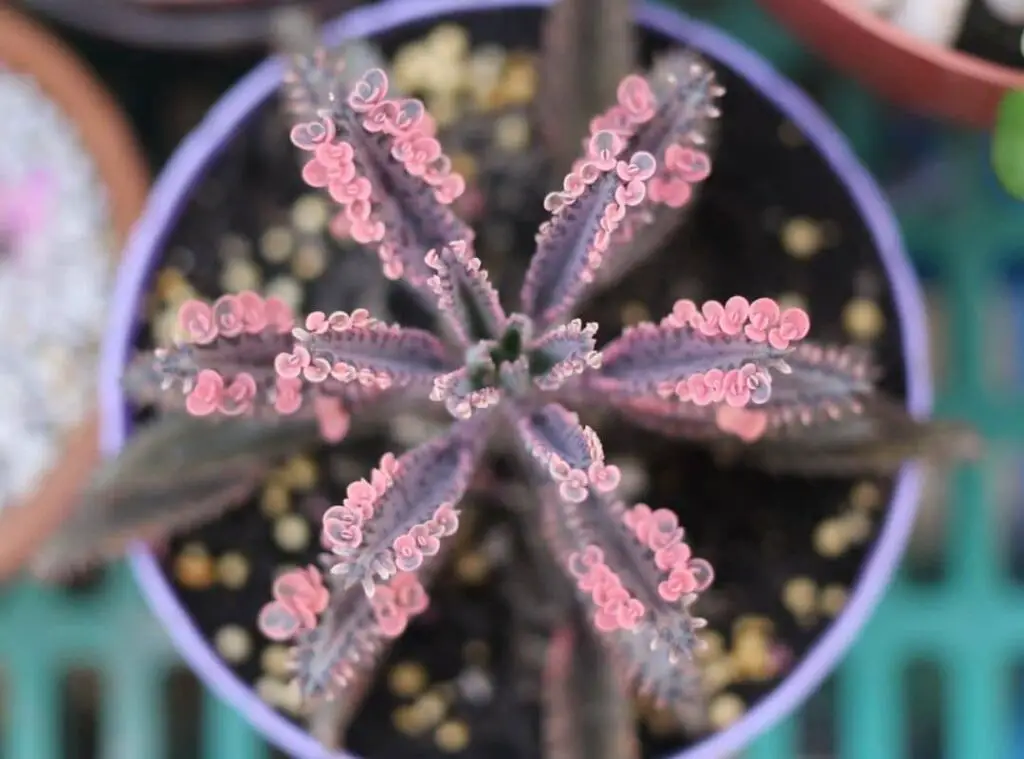Kalanchoe pink butterfly is one of the most sought plants by succulent enthusiasts. You could spot their leaves in numerous colors and many people were willing to add them due to this characteristic.
They are in fact a cross breed of mother of a thousand and Kalanchoe tubiflora.
They go by the common name called pink mother of thousands. Further, they are native plants in Madagascar and in Africa.
Kalanchoe pink butterfly is hardy plant and would be great picks even if you are a forgetful gardener. So, keep reading this article to enhance your knowledge on the right caring tips and on their propagation methods as well.

How do I identify kalanchoe pink butterfly?
Kalanchoe pink butterfly form leaves which are slender. Further they consist of tiny pink bulbils as well.
Those bulbils have a close resemblance to butterflies. Those bulbils could be spotted in pink as they do not contain chlorophyll.
In addition to their aforesaid features in the leaves, you could use their flowers also to identify the Kalanchoe pink butterfly plants.
They produce flowers in pink and you could expect them to flower in mid fall.
Size of the plants
Kalanchoe pink butterfly would rise up to 24-36 inches. (60-90cm). Moreover, they would be about 9-12 inches (22-30cm).
One look care guide
| Botanical Name | Kalanchoe pink butterfly |
| Common Name | Pink mother of thousands |
| Plant Type | Succulent |
| Mature Size | Maximum height of 24-36 inches. (60-90cm). Maximum width of 9-12 inches. (22-30cm) |
| Sun Exposure | Full sunlight to semi shade |
| Soil Type | Well-draining |
| Soil pH | Neutral |
| Bloom Time | Early fall |
| Flower Color | Pale pink |
| Hardiness Zones | USDA hardiness zones 9b-11b |
| Native Area | Asia , Madagascar |
| Toxicity | Toxic |
| Average price | $ 7 |
How do you take care of kalanchoe pink butterfly?
Light Requirement
When looking after the Kalanchoe pink butterfly plants well, exposing them to proper sunlight is critical.
As only then they grow vigorously and become vibrant in the colors. Best is to expose them to full sunlight and semi shade when growing them.
Hence when you grow Kalanchoe pink butterfly as indoor plants, you need to locate them in the brightest sunny spot at your home which could possibly be a bright sunny windowsill.
The exposure for full sunlight should be limited to 5-6 hours.
Furthermore, consider placing the potted Kalanchoe pink butterfly plants outdoors so that they can gain full sunlight, preferably in the morning hours.
If not, you may bring them outdoors during the afternoon if the sunrise is not too harsh.
On the other hand, locate them in a spot where they will be exposed only for semi shade when you grow them outdoors.
Refrain from exposing them to extremely intense sunlight as it would result in burns in the plants. Unfortunately, those sunburns will remain in the plants forever despite what you do to recover them.
Temperature and humidity
Kalanchoe pink butterfly are fond of growing in warmer temperature levels and hate to be exposed to frost.
Hence, if you live in a location where there will be frost conditions, I recommend growing them as indoor plants.
Keep in mind that these plants do not handle cold well. Even by mistake if you expose them to freezing temperatures, it could kill the plants.
If you have grown them outdoors and want to keep them outdoors during freezing temperatures, you may cover them with frost cloth.
They are not quite picky when it comes to right humidity levels as they are tolerant of all humidity levels. When you grow them indoors, they can survive room humidity levels.

Is it cold hardy?
Kalanchoe pink butterfly are not cold hardy plants at all.
USDA Hardiness Zone
Kalanchoe pink butterfly prefer to grow in USDA hardiness zones 9b-11b. Further elaborations of the zones are as follows.
- USDA Zone 9b: (25-30 °F) -3.9 to -1.1 °C
- USDA Zone 10a: (30-35 °F) -1.1 to 1.7 °C
- USDA Zone 10b: (35-40 °F) 1.7 to 4.4 °C
- USDA Zone 11a: (40-45 °F) 4.4 to 7.2 °C
- USDA Zone 11b: (45-50 °F) 7.2 to 10 °C
Watering Requirement
In addition to providing sufficient sunlight for Kalanchoe pink butterfly plants, watering them properly is also critical when taking care of them well.
Make sure that you water the plants once a week given that there are hot and dry weather conditions.
Further, always keep an eye on the soil condition whether it is too dry or still moist and depending on that you need to either water them or suspend watering them.
These are drought tolerant plants. Having said that, occasional watering is also crucial for them to grow vigorously.
Soil Requirement Type / ph.
Having excellent drainage in the soil mix is crucial when selecting the right soil mix to grow the Kalanchoe pink butterfly plants.
You have the option of using a succulent soil mix or a cactus soil mix as they have excellent drainage.
Once you go ahead with a free draining soil mix, it will ensure that there will be no excess moisture retained in the pot which is exactly what the plant is in need of.
Pot size Potting and Repotting.
When selecting the right pot, ensure that it has sufficient drainage. Only then will it allow the additional water to exit from the pots.
Clay pots or terracotta pots will go well with these plants. Once you use terracotta pots, it will absorb more moisture from the soil. On the other hand, If you use ceramic or plastic pots, they will act opposite.
When it comes to repotting, yodo not have to do it on a frequent basis. For example, if your beloved Kalanchoe pink butterfly plants are under attack by any insect pests, best is to repot them.
Moreover, if the plants are overgrown and when you freshly purchase them from the stores, you need to consider repotting them.
To repot, you need to first take the plants out from the pots and gently shake the succulents so that you can get rid of the older soil.
Next you could plant them in a fresh pot in which you filled with a free draining soil mix. Skip watering them for a week’s time so that they will have enough time to settle in the new growing conditions.
When they are fully established, you could continue with the regular care treatments.

Where to Plant
I recommend growing them in a location where they can gain strong sunlight levels. In addition to that, ensure that the selected place has warmer temperature levels as well.
Consider that you live in the aforesaid zone,so you may grow them as outdoor plants.
On the other hand, if you live in an area where there will be freezing temperatures, I encourage you to grow them as indoor plants.
Moreover, always go for a well-draining soil mix and for a porous material pot as well.
Fertilizer and time of year
Kalanchoe pink butterfly plants do not depend on any additional nutrients. In fact, they can thrive well with the nutrients available in the potting medium itself.
Having said that, if you consider giving them an extra boost in nutrients, the health of the plants would be benefitted from that. If you are using a balanced liquid fertilizer, you may use it every other week.
Dormancy
Kalanchoe pink butterfly plants go dormant in winter.
Can be toxic to pets
Kalanchoe pink butterfly plants are poisonous for pets such as cats, dogs, birds and even for cattle as well.
In fact, they contain a toxin called cardiac glycoside which is what causes the poisoning. In fact, it could cause casualties in the animals.
Further there will be symptoms such as excessive drooling, diarrhea, abdominal pains, change in the pulse etc of poisoning of these plants.
Hence, do not leave your pets or kids hanging around these plants. In case they ingest the Kalanchoe pink butterfly plants, best is to consult a veterinary doctor and go for their opinion. Do not wait until the affected pets show any symptoms.
Common bugs and illnesses
Chances are that you may encounter pests’ attacks from mealybugs and from aphids when growing the Kalanchoe pink butterfly plants.
To treat them, you could rub the affected parts of the plants with isopropyl alcohol.
Alternatively, you may use neem oil as well. In addition to that, make sure that you do not supply the Kalanchoe pink butterfly plants with an abundance of water as it would be quite unhealthy for them.
If you end up over watering them, they may suffer from root rot which could even be fatal to them. In addition to that it would make the plants more vulnerable to other fungal growths as well.
Special Care tips
I recommend pruning the Kalanchoe pink butterfly plants as it will make the plants look neat and attractive.
To prune, you could use gardening shears or a pair of scissors. However, before using them, ensure that they are disinfected so that there will be no infection or contamination of tools.
You may simply remove the unnecessary and dead plant parts when pruning.

How to propagate kalanchoe pink butterfly
You may use Kalanchoe pink butterfly leaf cuttings and stem cuttings to propagate them.
You cannot propagate them by dropping leaflets as their pink bulbils do not contain any chlorophyll whilst it is possible to do with the mother of a thousand plants.
How to propagate Kalanchoe pink butterfly with stem cuttings
It is so much fun to propagate the Kalanchoe pink butterfly by their cuttings. Further you could see faster results from the stem cutting method as well.
To start off, you need to obtain cuttings which are about 2-3 inches in length. Make sure that you take off the leaves if they have any.
Next Let them become callous. After that plant those in peat and perlite which are pre moistened.
Further you could consider enclosing the pot in plastic so that it will create a little terrarium and retain moisture within.
Finally you may leave the specimen in indirect sunlight. They will start to root within two to three weeks and by that time, you could transplant them.
How to propagate Kalanchoe pink butterfly with leaf cuttings
Make a clean pull of the Kalanchoe pink butterfly plant leaf whilst ensuring that there is no part of the leaf remaining in the plants.
Just like in the above method, make sure they develop callousness.
Ensure that you leave them in a dry place to develop callousness only for a couple days unless it would remove all the moisture it has within.
Finally plant them in a pot which you have filled with a cactus potting mix. Consider sprinkling water on them lightly so that you could keep the specimen moist.
However, do not leave them exposed to direct sunlight and do not over water them as well.Once they are fully established, you may treat them as regular plants.
Finally
Trust this article helps you to understand on how to look after the Kalanchoe pink butterfly plants well and how to grow them healthily.
So, start growing these beauties and enjoy this amazing experience.
Read Next : Kalanchoe Rosei Variegated | Simple But Elegant Succulent | Do You Know About Weird Plant Kalanchoe Daigremontiana? Kalanchoe Sexangularis ( One Of The Most Appealing Succulent )
